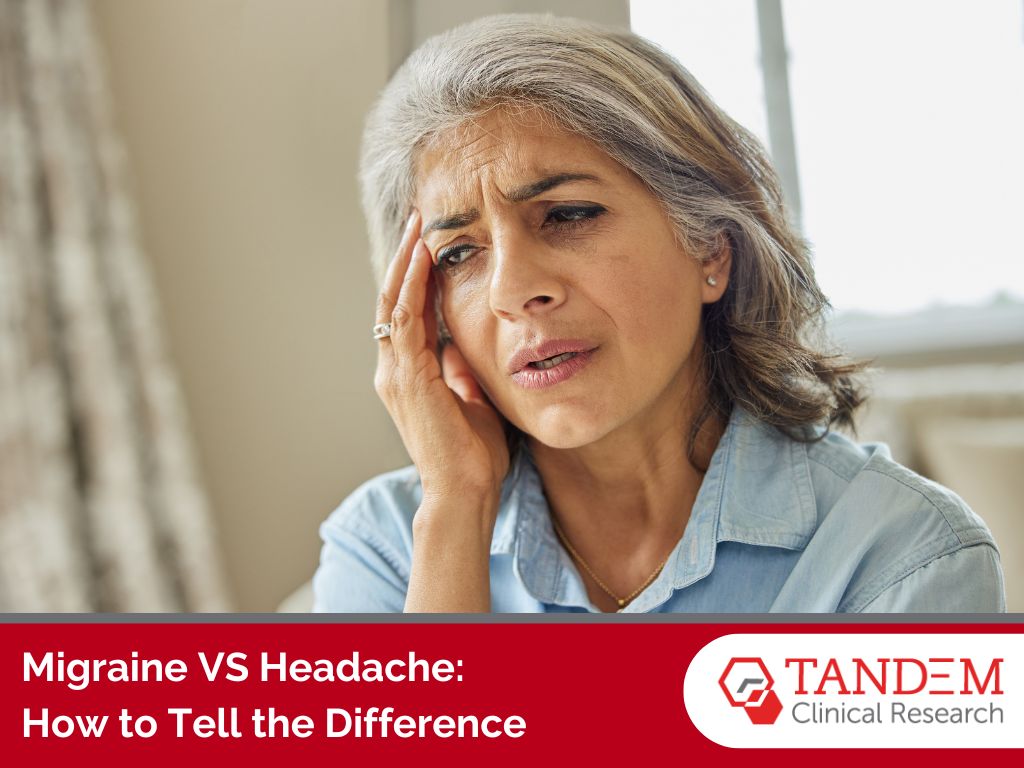According to the American Migraine Foundation, migraines are not just “bad” headaches. They are part of a neurological disorder characterized by recurrent episodes of moderate to severe headaches, as well as a wide range of related symptoms.
It’s estimated that more than 39 million Americans live with migraines, but many do not receive official diagnoses, making it difficult to gauge the true number. The symptoms can also vary significantly from person to person, making migraines even more challenging to identify.
Typically, migraines generate a throbbing and/or pulsating pain on one side of the head. This is caused by the activation of nerve fibers within the brain blood vessels traveling inside the meninges (three layers of membranes protecting the brain and spinal cord).
Some migraine episodes may last as few as four hours, while others can last for multiple days at a time if untreated. The frequency of migraines can also vary, depending on the individual.
What Causes Migraines?
Researchers have yet to narrow down a precise cause of migraines, but they believe that a combination of genetic and environmental factors contributes to their development. Some of the leading factors likely include…
Genetic Predisposition
Many studies have indicated that migraines tend to run in the family. If one or both parents have migraines, the risk of developing migraines increases in the child.
However, having a genetic predisposition for migraines does not guarantee that a person will experience migraines. The research simply indicates that they may be more susceptible to developing migraines compared to individuals without a family history of migraines.
Abnormal Brain Activity
Research suggests that several neurological changes occur during migraines, including the involvement of the trigeminal nerve. This major cranial nerve is responsible for the sensory information coming from the head and face, which results in the pain signals sent during a migraine.
Although more research is needed to fully understand brain activity that may contribute to migraines, it is thought that changes in the levels of certain chemicals (especially neurotransmitters) may play a role in the development of migraines.
Triggers
Individual migraine triggers can vary from person to person, but some common triggers include…
- Stress
- Hormonal changes in women
- Certain foods
- Alcohol
- Caffeine
- Changes in sleep patterns
- Bright lights
- Strong smells
- Certain medications
Blood Flow Changes
Scientists have observed changes in the blood flow in the brain and surrounding tissues during migraines. These changes can cause inflammation and irritation of the blood vessels, which contributes to the pain and symptoms experienced by the individual.
Environmental Factors
Environmental factors, such as changes in weather, high altitude, or exposure to certain chemicals or pollutants, can trigger migraines in some individuals.
Ultimately, migraines are complex and can involve multiple factors. What triggers a migraine for one person may not for another.
If you think you’ve been experiencing migraines, try to document your potential triggers so that you can discuss them with your healthcare provider.
Who Gets Migraines?
Migraines can occur in males and females of all ages but are especially prevalent in those ages 35 to 45. They also tend to affect women more than men. In fact, it’s estimated that women are up to three times as likely as men to experience migraines.
The prevalence of migraines in the female population is likely due to hormonal fluctuations, primarily during menstruation, as well as during and after pregnancy. Still, more research is necessary to fully understand what predisposes many women to migraines.
Most migraine sufferers have a family history of the disorder. However, migraines also occur in people who have other medical conditions, such as depression, anxiety, bipolar disorder, sleep disorders, and epilepsy.
How Common Are Migraines?
Migraines are considered fairly common, affecting a significant portion of the global population. According to the World Health Organization (WHO), an estimated 1 in 7 adults suffers from migraines.
The frequency and severity of migraines can vary among individuals. Some people may experience migraines only occasionally, while others may have more frequent and severe episodes.
Symptoms of Migraines
Migraines are usually characterized by severe headaches that are accompanied by various symptoms, such as…
Note: not everyone with migraines experiences all of these symptoms, and the severity and duration of symptoms can vary significantly.
Match With Migraine Clinical Trials
Have you been diagnosed with migraines? You may qualify for a clinical trial near you. At Tandem Clinical Research, we’ll help you match with…
- A research clinic in your area
- The latest treatments
- Scientific clinical studies
How Migraines Are Diagnosed
(1) Review Medical History
Most healthcare professionals will start by asking detailed questions about the patient’s headaches, including the frequency, duration, intensity, and associated symptoms. They will also inquire about the person’s family history of migraines and/or other headache disorders.
(2) Physical Examination
The healthcare provider may perform a physical examination to rule out other possible causes for the patient’s symptoms. This will likely include tests for reflexes, muscle strength, sensation, and coordination.
(3) Assess Diagnostic Criteria
Once the healthcare provider has the full picture of the patient’s history, symptoms, and physical wellness, they will then compare their findings to the diagnostic criteria established by recognized headache classification systems. This will help them determine if the headaches are indicative of migraines.
(4) Conduct Additional Tests
In most cases, specific diagnostic tests (such as imaging scans or blood tests) are not necessary for diagnosing migraines. However, some situations involving atypical symptoms or underlying conditions may require the use of additional testing.
Potential Treatments for Migraines
Unfortunately, there is currently no set treatment or “cure” for migraines. In most cases, prescribed treatment tactics aim to alleviate the symptoms during migraine episodes, or reduce the frequency or severity of future episodes.
If you suffer from migraines, your treatment will likely depend on your specific symptoms and responses to different interventions. Some common recommendations from your healthcare provider may include:
How to Support Others With Migraines
If your loved one is dealing with migraines, learning how to support them can be a crucial step in assisting them with symptom management. Whether it’s your family member or friend struggling with migraines, it’s a good idea to…
Educate Yourself
Take the time to learn about migraines and understand the condition. Familiarize yourself with common triggers, symptoms, and available treatment options. This will help you empathize with the person experiencing migraines, as well as make suggestions that can help them find relief during their episodes.
Offer a Safe Environment
During a migraine episode, it’s critical that you offer a calm, quiet environment for your loved one. Try to reduce bright lights, minimize noise, and provide a comfortable space where they can rest. You should also make sure that your loved one has anything they might need during their migraines, such as water or medications.
Provide Practical Assistance
If possible, offer assistance with tasks that may be challenging during a migraine attack, such as preparing meals, running errands, or taking care of household chores. Managing the symptoms of a migraine episode can be exhausting and physically demanding, and your loved one may require help with basic chores or responsibilities.
Remember: everyone’s experience with migraines is unique, so you should also ask your friend or family member how you can best support them. Show empathy, be patient, and offer assistance when they need it.
Migraine Clinical Trials
If you have been diagnosed with a migraine disorder, you could be a candidate for ongoing clinical studies. These trials allow researchers to obtain critical information about migraines, which can influence future treatment options.
Scientists and doctors are studying many aspects of migraine episodes. This includes the assessment of…
- new treatment possibilities
- how genetics and environmental factors increase the risk of migraines
- how the condition develops and progresses
At Tandem Clinical Research, we often conduct migraine clinical trials.
Match With Migraine Clinical Trials
Tandem Clinical Research matches individuals with reputable clinical trials conducted by pharmaceutical, biotech, and medical device companies. If you live near New York City, New Orleans, or Orlando, contact us to find the right trial for you.
We might not currently have a permanent cure for migraines, but scientists and doctors are researching potential new treatments. The more we learn about migraines and what causes them, the better we can become at preventing and treating them.
If you struggle with migraine headaches, we invite you to learn more about contributing to ongoing research.




